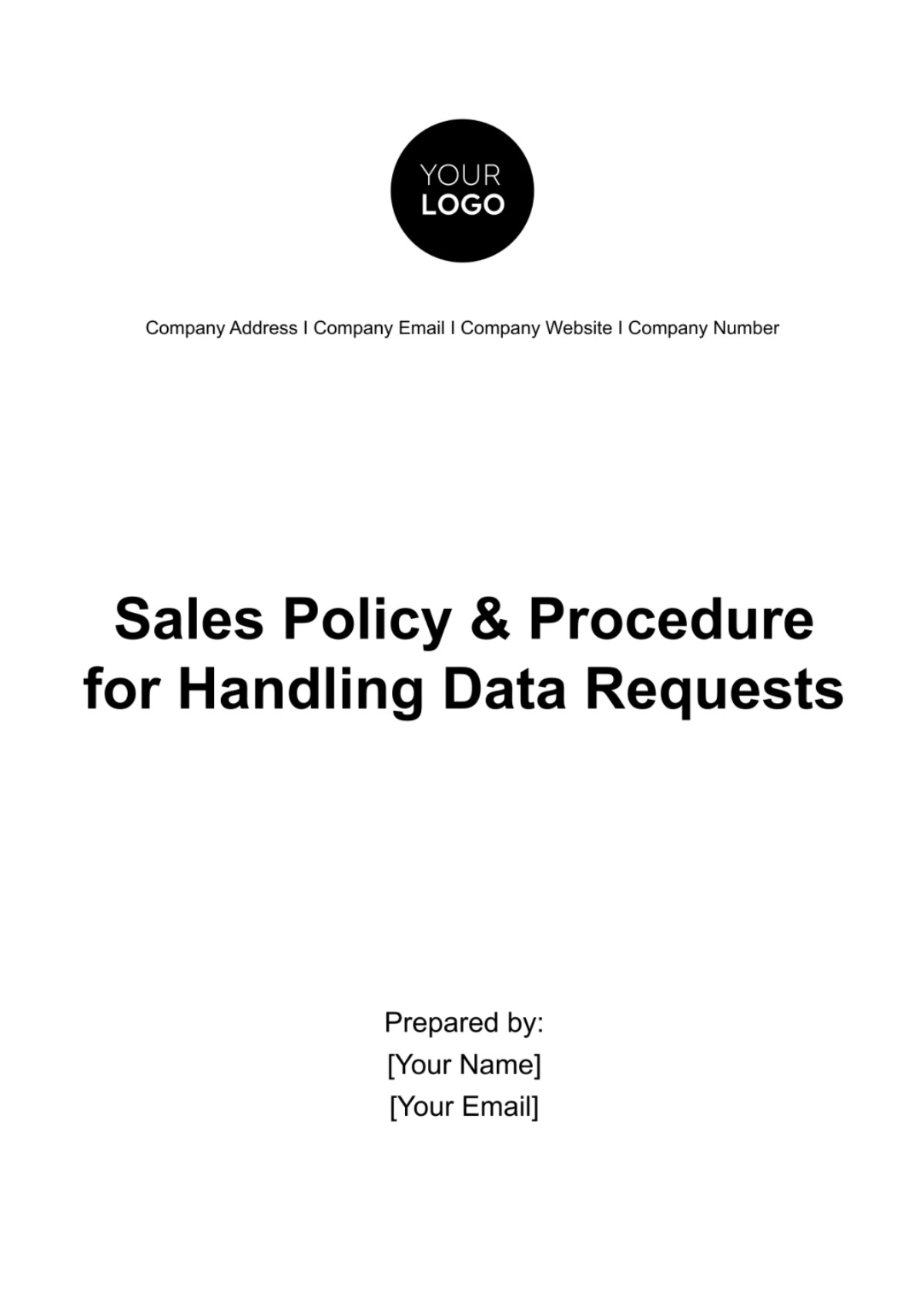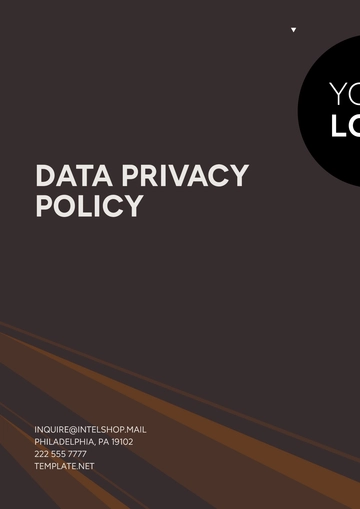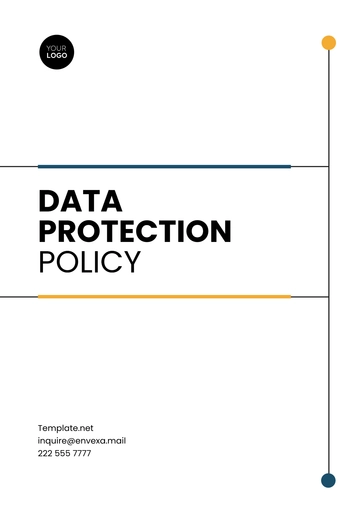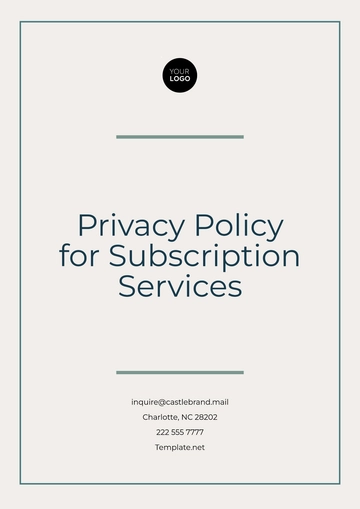Free Sales Policy & Procedure for Handling Data Requests

Data Requests
I. Introduction to Data Request Handling Policy
In today's data-driven landscape, where information is the lifeblood of effective decision-making, the ability to handle data requests efficiently, securely, and in compliance with regulations is paramount. This introductory section sets the stage for a comprehensive exploration of [Your Company Name]'s Data Request Handling Policy. It not only establishes the policy's purpose and scope but also underscores the critical role it plays in safeguarding data integrity, upholding compliance, and supporting the sales department's mission.
A. Purpose and Scope of the Policy
At the heart of this policy lies a clear and defined purpose: to provide a robust framework for the management of data requests within [Your Company Name]. This framework ensures that data requests are not just handled but handled efficiently, securely, and in a manner that complies with all relevant regulations. It's the blueprint that guides us in navigating the complex terrain of data requests.
Consider for a moment the analogy of a well-constructed bridge. Just as a bridge connects two distinct points, this policy connects the needs of data requestors with the data sources they seek. It bridges the gap between inquiry and response, setting a structured path to ensure data flows smoothly and securely.
B. Importance of Data Request Handling
The significance of effective data request handling cannot be overstated. It serves as the guardian of data accuracy, protecting the integrity of information critical to our decision-making processes. It acts as a fortress, safeguarding sensitive data from unauthorized access or misuse. Moreover, it stands as a sentinel, vigilant against the ever-evolving landscape of data privacy laws and regulations.
Consider the consequences of inadequate data request handling, where data is mishandled or compromised. The impact can be substantial, ranging from flawed decisions based on erroneous information to reputational damage and legal repercussions. The statistics corroborate this importance, with data breaches costing businesses an average of $3.86 million per breach in [Year], according to IBM's Cost of a Data Breach Report.
C. Applicability to the Sales Department
While the policy encompasses data request handling across [Your Company Name], it shines a spotlight on the sales department's unique needs and responsibilities. Sales, as a dynamic and data-intensive field, demands meticulous attention to data handling. Whether it's customer information, sales figures, or market insights, the sales department relies heavily on accurate and timely data.
This policy underscores the critical role data request handling plays in the context of sales-related activities. It ensures that data is not just a commodity but a strategic asset, empowering the sales team to make informed decisions, drive revenue, and enhance customer satisfaction.
In the subsequent sections of this policy document, we will delve deeper into the specifics of data request handling, addressing procedures, roles and responsibilities, and compliance considerations. Together, these components form a comprehensive guide to ensure that data requests are not only fulfilled but fulfilled in a manner that aligns with [Your Company Name]'s commitment to excellence, security, and compliance.
II. Request Submission and Validation
Efficient and secure data request handling begins with a well-structured submission and validation process. This section sheds light on the procedures and considerations that govern how data requests are submitted, ensuring that each request is legitimate, well-documented, and aligned with our company's goals and values.
A. Request Submission Process
Process | Details |
|---|---|
Methods of Submitting Data Requests | Accessibility and ease of use are vital when it comes to data request submissions. Therefore, we offer multiple avenues for requestors to submit their data requests. These include our company's designated request portal, email, and in-person submissions. Detailed and user-friendly guidelines for request submission are readily available on our company's intranet, ensuring that requestors can navigate the process effortlessly. |
Required Information in Data Requests | Clarity and completeness are the cornerstones of effective request handling. To streamline the process, requestors are expected to provide specific details within their requests. This information includes their name, department, the purpose of the request, and the specific data requirements. Incomplete requests, lacking any of these necessary details, will be held until all essential information is provided. This approach guarantees that each request is actionable and prevents unnecessary delays. |
B. Request Validation
Verification of Requestor's Identity: Data security begins with identity verification. To ensure that data requests are legitimate, we initiate a process to confirm the identity of the requestor against our company records. This essential step serves as the first line of defense against unauthorized access to sensitive data, safeguarding our information assets.
Confirming Legitimate Business Purpose: Each data request undergoes a meticulous review to ascertain that it aligns with a legitimate business purpose. This careful scrutiny ensures that data is accessed for valid and justifiable reasons, such as sales analysis or customer support. By confirming the legitimacy of each request, we maintain our commitment to data privacy and ethical data handling.
Data Request Timeline
Stage | Timeframe |
|---|---|
Request Submission | Within 24 hours |
Request Validation | 1-2 business days |
Data Retrieval | 2-5 business days |
Data Provision | 1-3 business days |
Total Turnaround | 5-10 business days |
In the forthcoming sections of this policy document, we will explore the subsequent stages of data request handling, including the process of request evaluation, approval, and fulfillment. These elements collectively contribute to a comprehensive framework that guarantees data requests are not just processed but processed with diligence, integrity, and alignment with the highest standards of data governance.
III. Data Retrieval and Provision
Efficiency and accuracy are at the heart of the Data Retrieval and Provision stage. In this section, we delve into the meticulous process of sourcing and delivering data in response to requests. Our commitment is to ensure that the right data is accessed securely and provided in a manner that best serves the requestor's needs.
A. Data Retrieval Process
Process | Details |
|---|---|
Identifying Data Sources | The first step in this process involves our dedicated data team identifying the most appropriate data sources. These sources encompass a rich tapestry of information, ranging from our CRM databases, and sales records, to market analysis reports. The selection of these sources is driven by the specific requirements outlined in the data request. |
Extracting Requested Data | Once the data sources have been pinpointed, the extraction process begins. This operation is conducted with the utmost care to maintain data integrity. Our experts ensure that only the data explicitly requested is extracted. This careful approach serves a dual purpose: it guarantees that requestors receive precisely what they need while safeguarding sensitive information that may not be pertinent to the request. |
B. Data Provision
Format of Data Delivery: Flexibility is key in data provision. We understand that different requestors have varying preferences when it comes to data formats. Therefore, we offer a range of delivery options, including Excel spreadsheets, PDF reports, or direct access to databases. The choice of format is closely aligned with the request's purpose. Just as a skilled tailor customizes clothing to fit a client's unique requirements, we tailor our data delivery to suit the specific needs of each requestor.
Timeliness of Data Delivery: Time is often of the essence when it comes to data requests. We recognize the importance of swift access to information in making informed decisions. Requests are processed with a sense of urgency, and data is delivered within the agreed-upon timeframe as stipulated in our service level agreement (SLA). This commitment ensures that requestors can rely on our timely provision of data to meet their objectives.
In the forthcoming sections of this policy document, we will delve further into the stages of request evaluation, approval, and communication, providing a comprehensive view of how we handle data requests from inception to fulfillment. Our overarching goal is to ensure that data requests are not just met but met with precision, timeliness, and the utmost respect for data integrity and security.
IV. Data Privacy and Security
The bedrock of our data request handling policy lies in the steadfast commitment to data privacy and security. In this section, we delve into the critical measures we employ to protect sensitive information and maintain the highest standards of data security.
A. Confidentiality Measures
Handling of Sensitive Data: Within our organization, the handling of sensitive data, such as personally identifiable information (PII), is a matter of utmost gravity. We understand that the trust of our clients and customers is built on the assurance that their data is treated with the utmost care and discretion. Therefore, access to such data is strictly restricted to authorized personnel only. This is akin to safeguarding a vault of priceless treasures, ensuring that only those with the right keys can access its contents.
Non-Disclosure Agreements (NDAs): In certain scenarios where sensitive data needs to be shared with external parties, such as third-party vendors or partners, we take an additional layer of precaution. Non-disclosure agreements (NDAs) are meticulously crafted and signed. These legal instruments serve as virtual fortresses of confidentiality, explicitly outlining the responsibilities and obligations of all parties involved. They stand as a testament to our unwavering commitment to protecting the confidentiality of the data we handle.
B. Data Security
Encryption and Secure Transfer: Data security is a multi-layered shield that encompasses both transmission and storage. During the transfer of data, be it internally or externally, we employ robust encryption protocols. This encryption transforms data into an unreadable format during transmission, rendering it inaccessible to unauthorized individuals. Furthermore, secure data transfer protocols are diligently adhered to, ensuring that data remains shielded from prying eyes throughout its journey. Think of this as sending data in a digitally sealed, tamper-proof envelope.
Access Controls and Authorization: Within our data infrastructure, access to data is meticulously controlled. Access rights are granted on a need-to-know basis, ensuring that only authorized individuals have the privilege of viewing or interacting with specific datasets. This is reinforced through role-based access controls, which dictate the level of access granted to each user. Just as a high-security facility permits entry to only those with the proper credentials, our data security mechanisms allow access only to those individuals who have been explicitly authorized.
As we navigate the intricacies of data request handling, these measures collectively create a fortress of data privacy and security. In the subsequent sections of this policy document, we will delve into the final stages of request approval, communication, and fulfillment, ensuring that our data requests are not only met but met with the highest standards of confidentiality and integrity.
V. Request Handling Documentation and Reporting
Documentation and reporting plays a pivotal role in ensuring transparency, accountability, and adherence to our established guidelines.
A. Record-Keeping
Logging Data Requests: In the digital realm, documentation is akin to our historical record, and every data request is a significant event. Therefore, we have established a robust system for logging all data requests. This comprehensive logging includes pertinent details such as the identity of requestors, the stated purposes of the requests, and a meticulous record of actions taken. These logs serve not only as a testament to our commitment to transparency but also as a valuable resource for audits and accountability.
Maintaining Request Records: Our approach to record-keeping goes beyond the immediate present. We recognize that historical data can provide valuable insights and a basis for accountability. As such, request records are meticulously maintained for a specified period, in strict accordance with our data retention policies. This preservation of records ensures that our actions today are open to scrutiny tomorrow and beyond, reinforcing our dedication to responsible data handling.
B. Reporting and Accountability
Regular Reporting to Compliance Officer: Transparency and oversight are paramount in our approach to data request handling. To this end, our compliance officer is regularly furnished with detailed reports on data request activities. These reports provide an overview of the volume and nature of requests received, offering a holistic view of our data request landscape. This constant communication with our compliance officer ensures that we maintain a vigilant eye on our adherence to policy, further enhancing our commitment to responsible data governance.
Handling Non-Compliance and Violations: In the event of non-compliance with this policy, swift and decisive action is taken. Our commitment to responsible data handling is unwavering, and any breaches of our established guidelines are addressed promptly. Appropriate actions are taken in response to non-compliance, which may include retraining, corrective measures, or, in cases of severe violation, disciplinary actions.
C. Compliance Checklist
The importance of a compliance checklist in Request Handling Documentation and Reporting can be outlined as follows:
Importance | Details |
|---|---|
Ensures Consistency | A compliance checklist guarantees that all request handling, documentation, and reporting processes adhere consistently to the established guidelines and best practices. |
Facilitates Transparency | It helps in maintaining clear and transparent records of all requests handled, ensuring that any actions taken can be easily traced and understood by relevant stakeholders. |
Supports Audit Readiness | With a comprehensive compliance checklist, organizations are better prepared for internal or external audits, as it simplifies the review of processes and documentation. |
Aids in Risk Management | It helps in identifying potential risks in the request handling process, allowing for the implementation of corrective actions before issues escalate. |
By adhering to this Sales Policy & Procedure for Handling Data Requests, we demonstrate our recognition of data as a valuable asset. We treat it with the care it deserves and use it responsibly in our sales operations. Compliance with this policy is not only essential to protect our company but also to maintain the trust of our stakeholders. This policy serves as a safeguard, ensuring that our data request handling is characterized by transparency, integrity, and adherence to the highest standards of ethical conduct.
- 100% Customizable, free editor
- Access 1 Million+ Templates, photo’s & graphics
- Download or share as a template
- Click and replace photos, graphics, text, backgrounds
- Resize, crop, AI write & more
- Access advanced editor
Optimize data management with the Sales Policy & Procedure for Handling Data Requests Template. Ensure compliance, security, and efficiency in data handling. Seamlessly create and implement policies to safeguard sensitive information, with this customizable and editable template using an Ai Editor Tool only at Template.net. Elevate your data management today and minimize risks effortlessly.
You may also like
- HR Policy
- Restaurant Policy
- Company Policy
- Accounting Policies and Procedures
- Website Policy
- Privacy Policy
- Safety Policy
- School Policy
- IT and Software Policy
- Law Firm Policy
- Construction Policy
- Interior Design Policy
- Travel Agency Policy
- Education Academic Policy
- Security Policy
- Real Estate Policy
- Expense Policy
- Software Policy





























